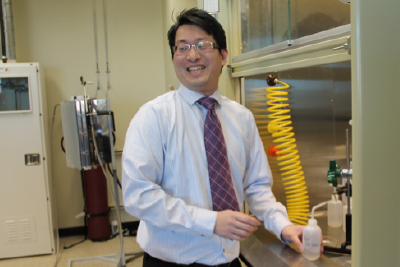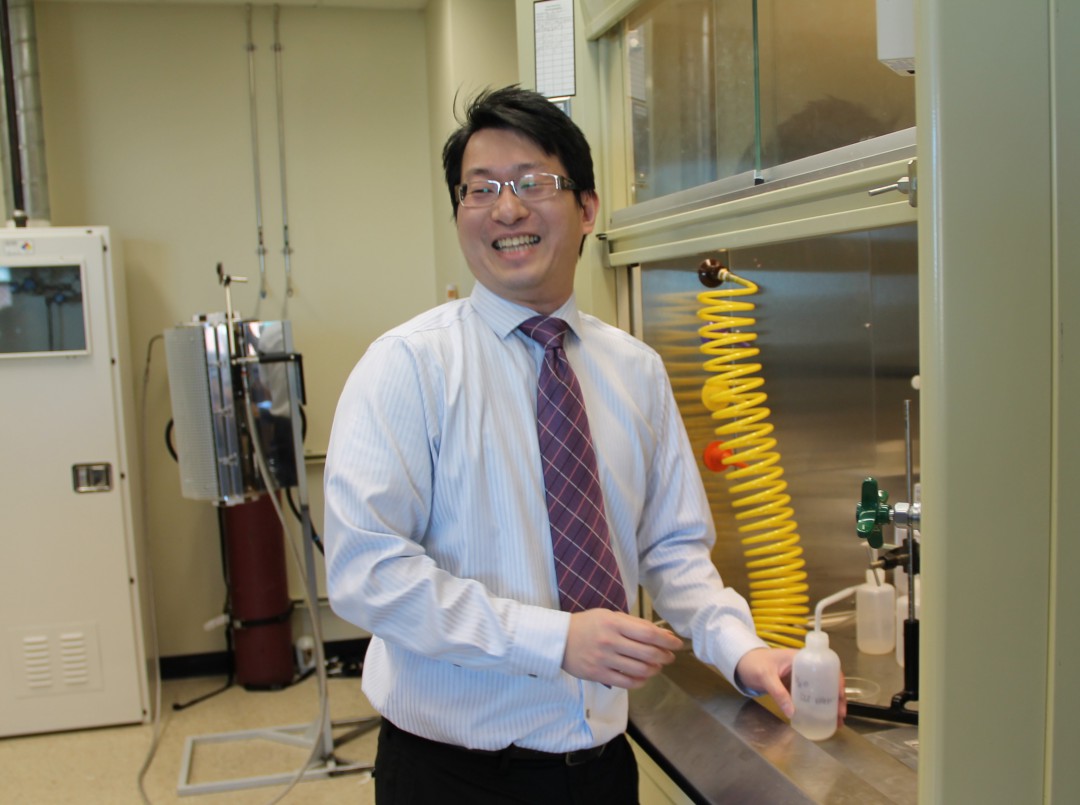Baylor Physicist Receives 2018 National Science Foundation CAREER Award


Dr. Howard Lee’s research in ultra-thin, nano-scale optical films has earned him a highly coveted NSF CAREER Award.
Contact: Whitney Richter, Director of Marketing and Communications, Office of the Vice Provost for Research, 254-710-7539
Written by: Gary Stokes, Office of the Vice Provost for Research
WACO, Texas (March 15, 2018) - Assistant Professor of Physics and Baylor Rising Star researcher Dr. Howard Lee has received a five-year, $500,000 CAREER Award from the National Science Foundation (NSF) for developing ultra-thin, nano-scale optical films with electrically tunable properties.
Dr. Lee’s research developing ultra-thin, nanoscale optics has the potential to dramatically reduce the size and weight of your smartphone, tablet or laptop while improving its performance.
The films, called metasurfaces, are only a few hundred atoms thick. In one form, the ultrathin metasurfaces serve as “perfect absorbers” because they can absorb 100 percent of the light that falls on them. That property alone could significantly improve efficiency of optical devices that require strong light absorption, such as photovoltaic solar cells.
In two other variants under development, the films might discretely filter out specific colors — wavelengths of light — in the visible and invisible regions of the electromagnetic spectrum, or they could be used to steer beams of light with exacting precision, all by varying the electrical voltage applied to the film. Lee says this ability to manipulate the electro-optical properties of the films by controlling the voltage is key to the project.
“We really want to demonstrate this electrical tunability, so we are trying to develop prototypes to show functionality for [the] perfect absorber, the color filter and the beam steering metasurfaces,” Lee said. “At the moment, no one is actually demonstrating this efficiently on all these properties.”
Dr. Dwight Russell, professor and interim chair of physics, weighed in on Lee’s recognition. “The NSF CAREER Award is a well-deserved recognition for Dr. Lee and his innovative work in the area of optical metasurfaces. I cannot be more pleased for him and look forward to the future research this award enables him to pursue.”
Dr. Truell Hyde, Vice Provost for Research, agrees. “Dr. Lee is an outstanding young researcher and clearly worthy of the NSF CAREER award. He has a very bright future and I look forward to watching it unfold.”
Beyond funding research, NSF CAREER grants carry a rigorous educational outreach mandate for recipients. This summer Lee will begin hosting at his lab electro-optics students from the nearby Texas State Technical College (TSTC) Waco campus to give them experience in nano-technology beyond what TSTC is currently able to provide.
“In the Waco area nano-technology [training] is not common, so we focus on the two-year colleges to give those students experience in advanced nano-technology that they cannot get anywhere else,” Lee said.
In addition, Lee will partner with Baylor’s Mayborn Museum to participate in its Portal to the Public designed to stimulate interest among the general public in current research and innovation. Through informal learning sessions the Portal to the Public Network, initially funded by Baylor’s Museum and Library Services and the NSF, connects public audiences with local scientists and engineers. Lee will also give an introductory lecture on nano-optics and potential applications at one of the museum’s regular Science Thursdays events.
The significance of Lee’s metasurfaces and nanophotonics research is underscored by his receipt just last year of a Young Faculty Award from the Defense Advanced Research Projects Agency (DARPA) for related nanophotonic work in nonlinear-optical regime.
“When you are winning grant awards like these, it enhances the research team’s confidence,” he said. “This is also good for my students because they have more resources and they know we are doing something great and we are competing with the top schools— MIT, Stanford and others — so they can get some confidence. We can actually show that we have projects that can really compete with [projects at] the top schools.”
